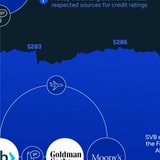
The US banking sector is currently in a state of chaos. Last week, tech startup lender Silicon Valley Bank (SVB) was shut down by regulators after it reported a $1.8 billion loss, a subsequent bank run saw its clients drawing on their deposits and shares in its parent company plummeted 86 percent.
The turmoil at SVB sparked fears of a contagion effect across the banking sector, and triggered the selloff of major banking stocks. Wall Street's four biggest banks — JPMorgan Chase, Bank of America, Wells Fargo and Morgan Stanley — shed a combined $55 billion in market value Thursday, and the price of the US' leading publicly-traded banks saw their biggest drop in almost three years.
The US government has since announced it will guarantee all deposit accounts at the institution, but how did SVB — the sixteenth largest bank in the US until Friday — get here? To help us understand, Visual Capitalist has visualized a timeline of the key events leading up to the bank's collapse.
Click image to enlarge
Via Visual Capitalist.
